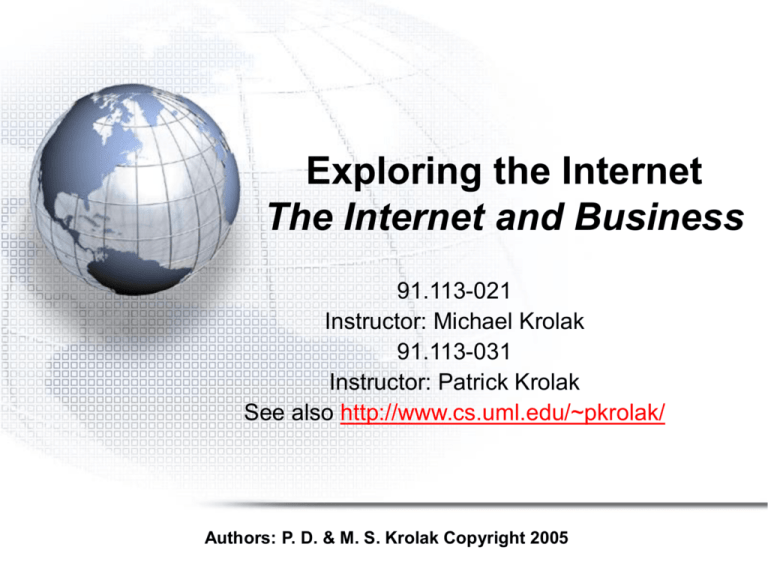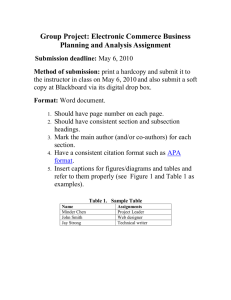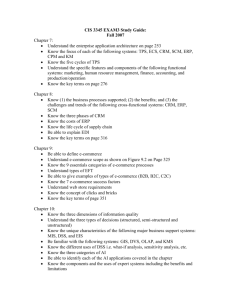Class12TheInternetAndBusiness
advertisement

Exploring the Internet The Internet and Business 91.113-021 Instructor: Michael Krolak 91.113-031 Instructor: Patrick Krolak See also http://www.cs.uml.edu/~pkrolak/ Authors: P. D. & M. S. Krolak Copyright 2005 Tonight • The Internet and Business (e-Commerce) • Building a form http://itom.fau.edu/sgalup/ISM6026_Spring2005_schedule.htm Class Announcements • Class Notes Have been posted. • The Final Blogs are Wednesday Dec. 21! • Class Vote Follow Up from Last Class • • • • Average grade: 90.9 Highest grade: 108 Maximum grade: 110 Mid-term was 30% of your grade! • Blogs are still due ( 2 per week) • Blogs count as 30% of your grade. Source: Internet Business The Internet was seen as a major area for business growth in the mid-90s and the “dot com” craze overcame Wall St. making young entrepreneurs millionaires (even Billionaires) over night. In the late 90s the bubble burst almost as rapidly. Some companies survived and prospered while many of the dot coms disappeared almost as fast as they had appeared. The traditional brick and mortar companies that adapted and modified their business model to utilize the Internet flourished; while those who did not or could not fell by the wayside. What is technology? Source: http://digilander.libero.it/stanleykubrick/2001/images/dawn06.jpg What is technology tech·nol·o·gy n. 1. The application of science, especially to industrial or commercial objectives. 2. The scientific method and material used to achieve a commercial or industrial objective. 3. The body of knowledge available to a society that is of use in fashioning implements, practicing manual arts and skills, and extracting or collecting materials. Source: http://www.dictionary.com What are barriers of entry? barriers of entry n. 1. In economics and especially in the theory of competition, barriers to entry are obstacles placed in the path of a firm which wants to enter a given market. The term may be used to refer to an individual who is barred from entering some profession or trade, or to a firm or even a country that is barred somehow from entering an industry or trade grouping Source: http://www.wikipedia.com Hmmm. . . What does that make you think of? Maybe Barriers of Trade? • Tariffs - An added cost when you bring a good across a border • Non-tariff barriers to trade – State subsidies, procurement, trading, ownership – National regulations on health, safety, employment – Quotas How about the Digital Divide? digital divide n. 1. A social issue referring to the differing amount of information between those who have access to the Internet (especially broadband access) and those who do not. The term became popular among concerned parties, such as scholars, policy makers, and advocacy groups, in the late 1990s Also referred to as the digital split Source: http://www.websters-online-dictionary.org/definition/DIGITAL+DIVIDE What are economies of scale? economies of scale n. 1. The ability to leverage capabilities and infrastructure to increase a market participant’s or a network of participant’s revenues or profits within a single product line or market. Example If you shop at Costco or Sam’s Club, you are leveraging economies of scale. Source: Applegate, Austin, and McFarlan, “Corporate Information and Management” What could you leverage on the Internet? What is E-Commerce? Electronic commerce or e-commerce n. 1. The distributing, buying, selling, marketing, and servicing of products or services over electronic systems such as computer networks. The information technology industry might see it as an electronic business application aimed at commercial transactions. It can involve electronic funds transfer, supply chain management, e-marketing, online marketing, online transaction processing, electronic data interchange, automated inventory management systems, and automated data-collection systems. It typically uses electronic communications technology such as the Internet, extranets, e-mail, Ebooks, databases, and mobile phones. According to Forrester Research (as cited in Kessler, 2003), electronic commerce generated sales worth US $12.2 billion in 2003. Source: http://en.wikipedia.org/wiki/E-commerce E-Commerce Market Size and Trends The increase and penetration of online use in the US increases the potential market size for E-Commerce on an annual basis. A large share of the expected growth in Internet commerce can be attributed to the increase in the online population: •U.S. online population estimated to increase nearly 50%, from 141.5 million in 2001 to 210.8 million by 2006 (CAGR of 8.2%). [1] (see Figure ) •U.S. online retail sales will grow from $47.8 billion in 2002 to an estimated $130.3 billion in 2006 (see accompanying Figure). [2] •There are 2.3 million small companies in the U.S.; with 16% of these in the retail trade and 60% of all small companies have an online presence – potential market size for our service is upwards of 200,000 companies. [3] •Annual spending per buyer will increase from $457 in 2001 to $784 in 2006. [4] Source: http://www.goecart.com/ecommerce_solutions_facts.asp The dot com craze The Dot Com Bubble • Based on the expectation for e-commerce growth, venture capital companies rushed in to find and fund new companies. • Companies were often funded even though they had an immature leadership, a six page business plan, and no discernable business model. • The dot com boon quickly showed the first company with the idea could get funded, perhaps the second but not many others. • The boon ended after large numbers went to the equity market (Initial Public Offerings, IPOs) and it became clear that they were way overvalued without a long term change of making a profit. The inevitable bursting of the bubble and the consolidation of the market Source: www.londonstimes.us/.../johann_dotcom.gif The bubble burst! Netflix vs. Blockbuster • Blockbuster – Started in Massachusetts • Business Model – – rent VCRs and DVDs from local stores – Charge for each selections – LATE FEES • While Blockbuster still survives it has had to modify its Late Fee policy • Blockbuster and Wal-Mart now are trying to compete using a NetFlixs business model • Netflixs Business model – – Rent DVDs online with tools for creating lists of movies desired, history of orders, etc. – Selections are sent thru the mail – Allows DVDs at a time for an unlimited time. – Ships DVDs in a postage paid return envelope, – One monthly fee for all selections during the month and NO Late Fees Amazon.com vs. the traditional retailer • Founder and CEO-- Jeff Bezos • Amazon.com business model to be the Wal-Mart of the web. • After the bubble burst it maintained the vision despite lack of profits, it created a stable and reliable supply chain, and expended into new products. • Pioneered consumer's evaluations and used tools to determine what buyers of similar products purchased to suggest further sales. Dell vs. Gateway Computers • Gateway business modelsell computers as a commodity against the high overhead corporate sales teams of the old line computer makers. • Go to the retail site and place an order for a customized computer that would be fabricated and shipped in 3 business days. • Dell offered the same customization in an e-tail mode. • Customer service is done through off shore phone service. Lycos.com • • • • Founder Bob Davis, a Northeastern graduate, did not know how to use a computer until he became the CEO. Location: Waltham, MA. Business model: Search engine and portal Funded initially for $2M, late in the market behind Yahoo, etc. – – – • • Considered itself a media company, and viewed Old Economy conglomerates like Viacom and Disney as role models. Rather than swallowing companies whole, Lycos would become an umbrella under which numerous established brands would cooperate and promote one another. The key was to build out quickly. Buy a company, make the necessary adjustments, and move on to the next deal, IPO in 1997 for $40M & at the time -- fastest IPO in NASDAQ history Lycos, after turning down a stock deal by USA Networks for $6-billionl, is acquired by Terra, the Internet arm of Telefónica, the Spanish telecommunications giant. The trade for a large amount of cash was done at the top of the market, Davis walked away a rich man. Source: http://www.bizforward.com/bos/issues/2001-07/lycos Monster.com vs. Newpapers • Business model: A global jobs portal for business and job seekers. • Founder: Jeff Taylor, U Mass graduate. His area of concentration was "Human Capital and Marketing in the New Economy." • The Boston Globe was offered the chance to buy out Monster.com in its inception. Source: http://www.umass.edu/commencement/2001/speakers.html Ebay • Ebay created the first successful auction site where buyers and sellers could sell everything from heirlooms to junk in the attic. • Pioneered the concepts of buyers comments on sellers, invented means to insure the buyer from fraud, etc. • Allowed thousands to create basement businesses to sell overstocks, art, handicraft, etc. Google, Yahoo, and Microsoft chase the geographic search engine market • Google, Yahoo, and Microsoft have staked out the geographic search engine to do battle. • Geographic search engines provide: – People and places near an address, – Provide information about a place, location, directions, services located in the area, etc. – GIS, Satellite imagery, 3-d view of terrain and buildings Source: http://earth.google.com/ What are the requirements for using the Internet for commerce? e-commerce has many forms. Electronic Retail or e-tail is the most common one. E-tail from the view point of the customer Service: The problem that is presented to every e-commerce strategy is this: 1. How to utilize the advent of automated service without losing customer satisfaction or attraction? The pleasure of shopping and dealing with real salespersons versus the time saved via online purchases. 2. What type of service is the e-commerce consumer expecting from a commercial site? Most e-commerce sites, certainly around the Holidays, try to focus on marketing the speed and convenience of their service. The consumer would rather wait a few days for the product to be shipped to them, than spend time in lines. Therefore, when designing a e-commerce site, one should recognize the importance of speed and convenience. 3. The majority of the customers of any e-commerce site will not be computer literate. Therefore, the site should be easy enough to use that someone who can do nothing more than browse web sites can still purchase goods. Security: An important rule of marketing is: To make a sale you must gain the consumer's trust. • This is why there exist warranties, price protection guarantees and assorted other marketing strategies. • With e-commerce, one must develop a strategy to overcome the consumer fears that develop by losing the person-to-person experience. Security is the largest concern of consumers on the Internet. If consumers don't trust their credit card number to the process, you will lose their sales. • Therefore, while security can cost a small fortune, it is a necessary investment in today's e-commerce market. Safety: • While it is rare the individuals physical safety is compromised by access to information that is too easily obtainable over the web, some people risk home invasion by publicly advertising events that take them away from home, i.e. weddings, funerals, etc. The convenience of online bridal registries and similar services open the individual to more that a gift from Aunt Susie. • The more dangerous issue and growing more common crime is identity theft. The gathering of information of social security number, credit cards, and few other pieces of data can be woven into a fabric of another life that could lead to bankruptcy, loss of family and friends, and other undesirable outcomes. • E-business must protect the customer data if it intends to stay in business and should demand that other take a similar stand to push for a public code of conduct and support harsh penalties for crimes like identity theft. Privacy and Confidentiality • In the early 90’s, one of the greatest fears of the users of the Internet was that an Orwellian society was coming of age. The vision of Big Brother collecting information from the Internet and using it in ways the consumer would never suspect nor want, caused many pioneers of the Internet to pause. • Due to the sensitivity of this issue, e-commerce sites must respect the privacy of its consumers. Ethical issues come into the picture when one conceives of storing consumer information in large databases that will later use the data to determine how one views the site. • Personalization over the Internet could come at a very high cost to the consumer if e-commerce sites didn't respect the confidentiality of the consumers. Once again, in order to effectively market a site, one must build a trust between the consumer and the company. Invasions of privacy are obvious breeches of that trust and would only gain short term profits. Eventually consumers would refuse to use a site that violated the privacy of a consumer. Reliability and Repeatability • In a market where technological fads come and go within a matter of months, the stability and sustainability of a site is a great asset. New sites are popping up on the internet at a mind boggling rate. • Consumers will hesitate to use fly-by-night sites, because they can not offer reliability and repeatability. The most reliable sites on the internet will guarantee delivery of products and will even track the products’ shipping status. Such practices allow the consumer to feel at ease with buying goods on the internet and it will cause them to return to your site. • In short a e-tailer is only as strong as its supply chain. Telework or Telecommuting The cost of leasing or buying office space, the cost and loss of productivity during commuting, and the workers’ desire to remain part of the work force during the child rearing years has lead government and industry to begin experimenting with a new work model. Called telework or telecommuting the worker uses a home office along with the Internet and phone to maintain accountability, transmit work, and to take part in tele (video) conferences, and to stay in the office life and flow of business. The worker may or may not actually go into an office weekly, In some cases the worker rents a temporary or virtual office to hold meeting, prepare presentations, and to share secretarial and other support. Internet Services for time-strapped families • Online grocery shopping and delivery Peapod.com • Online banking and bill paying BankofAmerica.com • Online Travel Agents and low cost tickets Orbitz.com • Distance Learning Umassonline.net The Internet and the family The family in the US is no longer the “Leave It To Beaver” television image of the 1950’s. 1. The two parent, two children families with one wage earner are now a distinct minority. 2. Single parent or divorced single parent families are common. 3. Blended families are growing in large numbers. 4. Gay marriage and civil unions are now recognized in several states. 5. The families are being formed later and with fewer children and more disposable income. 6. American families with two wage earners are working increasingly longer hours. 7. The global trend in other industrial countries -- workers and management alike are seeking shorter work weeks.. 8. Telecommuting (working out of a home office for government or industry) and/or home based businesses depend on the Internet for services, data, and markets. The advent of Internet and wireless devices is effecting the quality of life • The constant barrage of music, video, and information shortens our attention span and allows little quiet time for family. • The wireless devices means we are always on call and can always be interrupted.









